Trust based COVID-19 vaccine distribution using blockchain technology
Abstract
The COVID-19 outbreak has impacted huge number of individuals all around the world and has caused a great economic loss all over the world. Vaccination is most effective solution to prevent this disease. It helps in protecting the whole community. It improves the human immune system and fights against corona virus reducing the death rate. This paper deals with the different types of COVID-19 vaccine and their related distribution, it includes measures to ensure safe and secured distribution of the vaccine through block chain technology with the help of supply chain. Any malfunction in the chain is identified by the trust value of the function point method and the value of the Markov Chain.
1Introduction
Coronavirus Pandemic has contaminated and killed millions and lakhs of individuals overall driving the whole worldwide populace into a total lockdown stopping occupied economies with deficiency of nine trillion dollars. Social removing and lockdown have been the best way to lull disease overall including India. Phenomenal worldwide size of lockdown has made all nations scramble to track down approaches to successfully facilitate the reaction to oversee and get rid of the sickness.
61.5% of the total populace has gotten something like one portion of a COVID-19 vaccination. 10.24 billion Dosages have been managed around the world, and 23.68 million are currently regulated every day. Just 10.4% of individuals in low-pay nations have gotten somewhere around one portion [1].
Figure 1 shows that breakdown of vaccination by those that have been incompletely or completely vaccinated [2]. An individual is viewed as incompletely vaccinated assuming they have gotten just one dose or a 2-dose vaccination convention. An individual is viewed as completely vaccinated assuming that they have gotten a solitary portion immunization or the two dosages of a two-portion antibody [3].
Fig. 1
Statistics of vaccinated people worldwide.
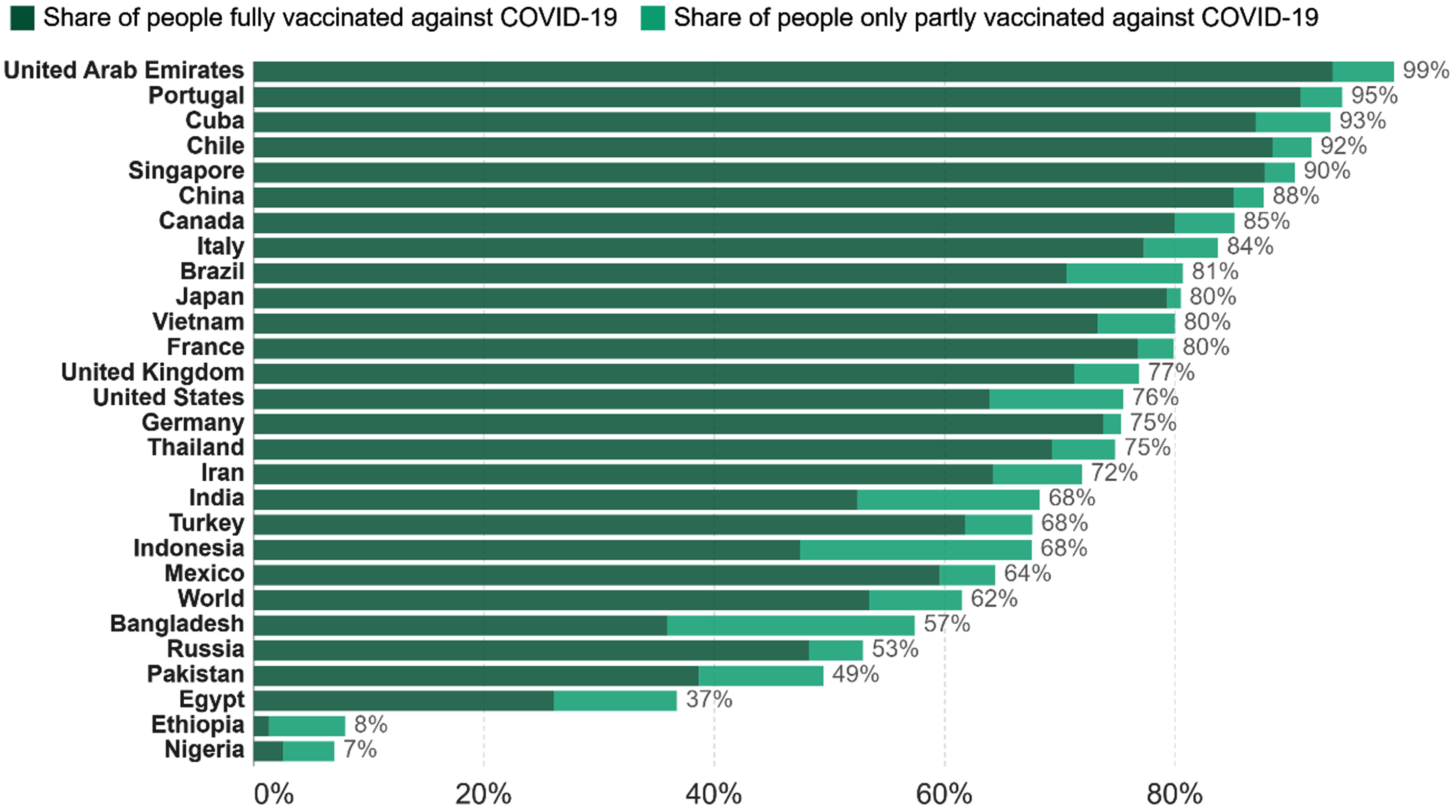
All known data and innovations which work best to deal with wellbeing or store network the board instruments even in most better nations have not been sufficient than handle this phenomenal worldwide emergency in current history [4]. Focal and State legislatures of India have generally depended on divided mechanical reception which has turned into an undeniably challenging assignment to organize between numerous divisions and services with skeletal staff [5].
Quickly diminishing food stocks and financial capacity of government to adapt up to giving the necessities of billion individuals and expanding monetary misfortunes are compelling legislatures to consider resuming the monetary action somewhat in non-tainted regions consequently opening prospects of additional contamination with obscure outcomes on the off chance that a satisfactory arrangement isn’t set up [6]. The most effective resolution is vaccination. Vaccination can control the outbreak of the disease enormously and decreases death rates. COVID-19’s development may be tracked in real time as new data are presented everyday based on patients affected ratio. However, choices which are made based on these data are usually not precise, these data provide a substantial challenge. In the pandemic situation is crucial to validate based on statistical data. In order to track the pandemic’s progress, proper data must also be updated and maintained. Contact-tracing to track COVID-19 instances, tech titans, researchers, and healthcare officials have used smartphone applications that utilize NFC and IEEE802.15 devices to trace the proximity features or geo location monitoring functions. In order to analyze how quickly the disease spreads reliable data is necessary to understand the dynamics of the pandemic [7].
2Global Impact
The COVID-19 is having an influence on people’s health as well as their daily lives and the global economy. To limit and minimize the pandemic, many governments have proclaimed prohibitive measures like lockdown and remain at-home. As a result, by early march, nearly 4.5 billion individuals, or half of the earth population and their mobility limited. Most factories, marketplaces, and companies would be temporarily closed, public transportation would be suspended, and construction activities would be halted as a result of the lockdown [8]. As a result, COVID-19 has had a substantial effect on enterprises and the global economy, in addition to people’s health. The economic recession was severe, and the damage was extensive, due to the suspension of many firms. Supply chain disruptions, lost tourists, rising joblessness, and a food calamity are among the economic consequences of COVID-19 [9, 10].
3Healthcare supply chain
The COVID outbreak has wreaked havoc on the world’s supply chains. Several businesses have closed owing to health and safety concerns, and there is a surge in demand for specialized products, especially personal protective equipment and medical supplies. Many consumers are under pressure to obtain supply from unidentified sources or of mysterious quality as a result of increased demand for goods from anonym’s sources or of uncertain quality [11]. Long supply lines provide an excessive amount of obscurity, making measuring and planning supplies difficult. Block chain is the appropriate solution for supply chains, as it can associate all partners into a solitary inventory network widespread source while showing straightforwardness and securely eliminating information storehouses. As a result, a huge number of block chain configurations were used in supply chain management during the COVID-19 outbreak. Block chain speeds up the validation process by removing anonym’s partners and avoids interruptions in handling the operations. Shorter handling and processing times, lower costs, lower operational risks, and faster settlements for all parties concerned, including the government, are just a few of the advantages. The some of the blockchain (Vechain) technology ensures the trustworthiness and reliability of new KN95 masks imported from China, while also allowing manufacture offices and services to collaborate effortlessly. From codes to packages to materials, all jobs related to serum production are recorded and stored in designated registers [12, 13].
4Consumer data privacy protection
In these tough situations, a harmony between information assortment and information security should be accomplished. Blockchain can be utilized to gather and dissect clinical information all the more proficiently, as well as track patients’ movements to ensure legitimate social segregation while keeping up with their characters [14]. On a blockchain stage, there is no focal power, and clients have total responsibility for information. They can share information that is basic to the COVID’s annihilation while holding their security and secrecy. Moreover, by following COVIDS, state run administrations and medical services associations can build information gathering while clients can be guaranteed of information security. For COVID-19 Bluetooth contact, a gathering of European security experts planned a blockchain-based design. MYNXG, a German computerized fire up, has additionally fostered a blockchain-based framework that utilizes cell phones while safeguarding client security.
A solution based on block chain for Indian PDS (Public distribution system) using national Id’s like ration card and adhaar card which are linked to each other has been created. Ration cards are used in Indian PDS to get subsidies. A recent initiative where each Indian citizen is provided with an identity number called the adhaar. This design gives a careful data about the inventory network and conceptualizes how the innovation can be really utilized. It examines the leftover activities of PDS and recognized the rundown of conceivable chain codes and relating shrewd agreements to computerize specific manual dynamic undertakings. It provides frame worked answers to the issues that the Indian PDS system faces such as improper authentication of beneficiary and inconsistency of data due to bad maintenance of records. The information investigation for various partners to pursue right choices have additionally been found. The calculated system for capacity and investigation of information across on-chain and off - chain has been presented to select which kind of supply chain contracts data goes where in addition to enhancing the performance of the proposed block chain framework. A association blockchain based arrangement has been introduced to stay away from the utilization of unusable proportion cards and wastage of food grains during the cycle by utilizing a special ID framework for recipients in Indian PDS. This solution has the ability to improve cooperation between the PDS stakeholders and provides transparency in addition to preventing fraudulent transactions [15].
This paper analyses the detailed report on vaccine distribution that are used in the different countries. There are different risk factors consider to vaccine distribution
1. Traceability
2. Assurance
3. Delivery risk
4. Safety
5Proposed model
The proposed solution supports large amounts of transaction and prevents the deficient authentic identification of beneficiaries and overcomes all the other issues of authentication and traceability system. It helps in inter changing trusted data about the life cycle of the vaccine distribution. All the stakeholders will have transparency of the supply chain almost in real time. It supports the process of automation and receiver identification. The large volume of data can be stored off-chain whereas the hash references of the information can be kept on-chain. In the event of any breakdown in the off chain information it tends to be effectively followed to the ventral organizations liable for dissemination and the essential activities can be taken further. Traceability is important factor of vaccine distribution in blockchain technology. There are following factors are considered 1.Realtime alerts 2. Sourcing 3.Increasing transparency of end to end delivery.
Figure 2 shows that Node 1 to Node 8 consider as a blocks. Each and every blocks contains source and destination address of crypto-id with hash key values.Node-1 to Node-8 data transmission can be considered as data movement. Each and every data movement can be calculated as energy (read and write).Based on the block size and data movement can be monitored and analyzed through function point.
Fig. 2
Representation of node traceability.
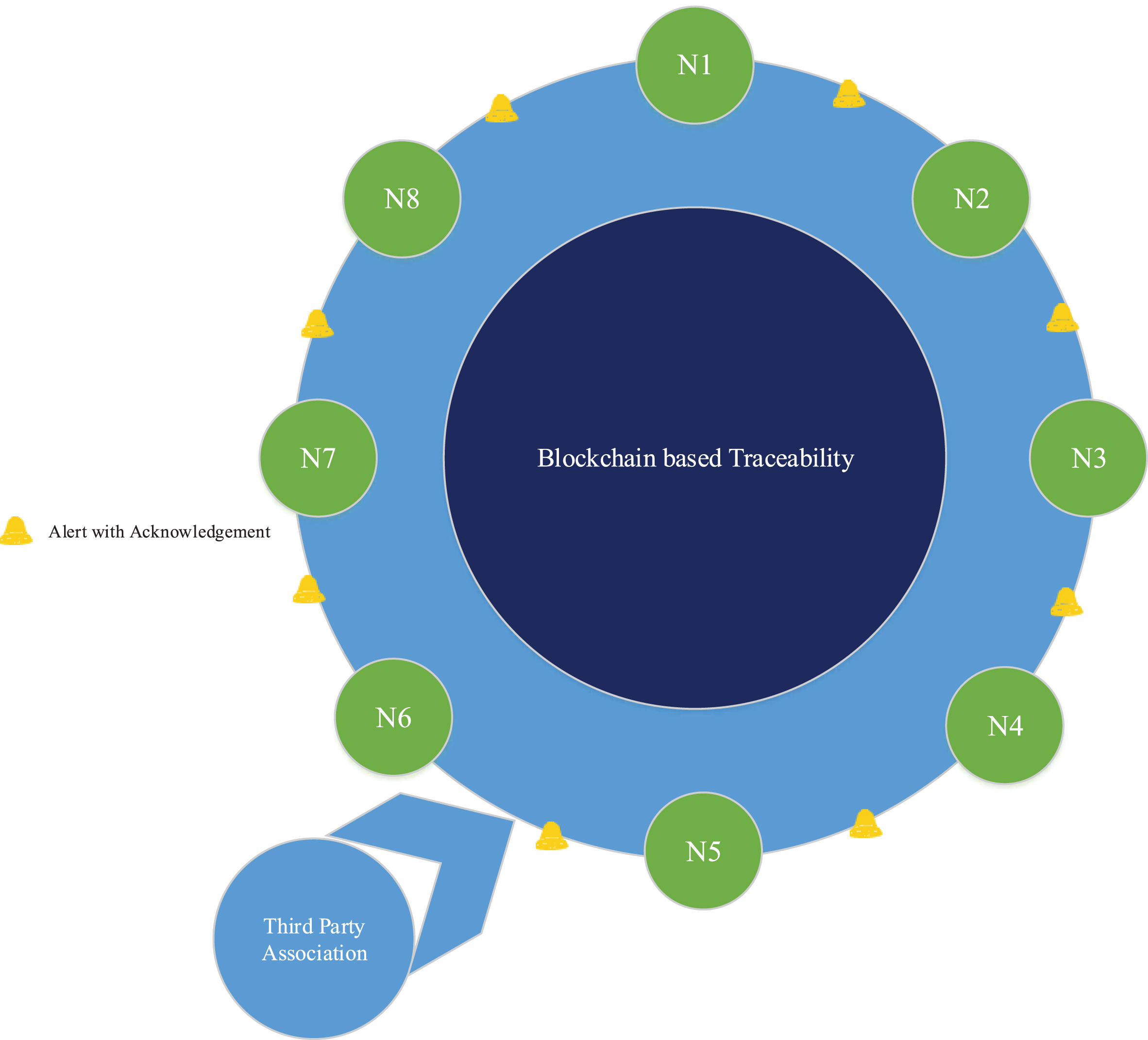
6Problem statement in markov model
A Markov chain is a model of the arbitrary movement of a blocks in a discrete or continuous movement in the areas. It deals with the chain states that the probability distribution is dependent on the present state. This model provides effective identification of the movement of blocks. In discrete time, the place of the block called the condition of the Markov chain-is recorded along with each block movement in time,that is, now and again 0, 1, 2 ... .n. In nonstop time, the block state is seen consistently t≥0 [16].
The discrete markov chain contains in the order of blocks as N1, N2, ... .,Nn each variable is called as markov property. Markov blocks states that distribution of upcoming state Nn +1 depends only on current blocks Nn and not depends on the previous blocks Nn–1, Nn–2... N1.
Figure 3 shows that node transition diagram of three possible transient states N1, N2 and N3.The data movement of one state to other states shows the possibilities of Mij. Initially Mij = 0.
Fig. 3
Node-state transition diagram.
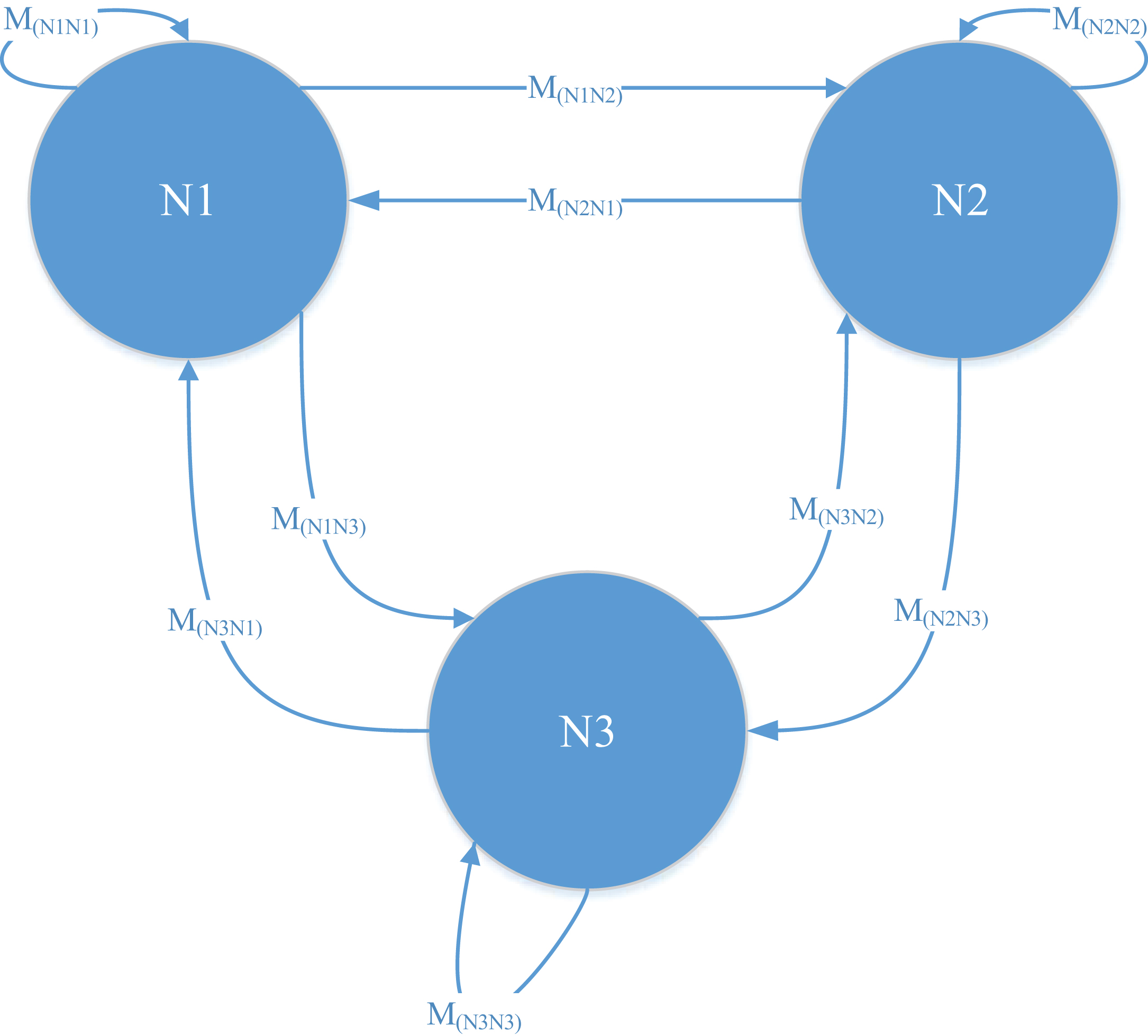
We currently know how to acquire the possibility changing starting with one state then onto the next, however what about observing the opportunity of that progress happening over numerous means? To formalize this, we presently need to decide the likelihood of moving from state I to state J over M advances. It just so happens, this is really exceptionally easy to discover. Given a progress framework P, this not entirely set in stone by ascertaining the worth of section (I, J) of the grid acquired by raising P to the force of M. For little upsides of M, this should handily be possible by hand with rehashed augmentation. Nonetheless, for huge upsides of M, assuming that you know about straightforward Linear Algebra, a more proficient method for raising a network to a power is to initially diagonalize the lattice.
The likelihood dissemination of advances starting with one square then onto the next square can be addressed into a change network M=(Mij)i,j, everywhere component of locus (i, j) addresses the progress likelihood pij. E.g., if r = 3 the change framework M [17]
Based on the time complexity block transition state can be categorized in the following ways,
A block b state is null X (Tb ⟶b)=+∞.
A block b state is positive X (Tb ⟶b)< +∞.
A block b state absorbing other state
The following criteria block movement to analyze the block movement current state to other state. Data movement from state bi to state bj is Tij steps to arrives the chain to the state bj is that X0 = bi.
The probability of the distribution Tij calculated by
Markov chain with set of possible three possible block states B={b1, b2, b3}
6.1Transition matrix
A-Transition matrix, N1-Starting node of the block, n-Do n steps, N3-End node of the block
1. Def Transition (A,N1,n,N3)
For i in range(n);
S = markov_move(A,N1)
return N1==N3
Consider as a transition matrix,
If S,S11 = 0.5, The chain is complex to communicate with other states
The active state of the chain is the initial state
S0=(0 1 0)
The probability can be computed as next data movement between the states or blocks in the chain
Next blocks probability of states
Sr(Q2 = b3 | Q0 = b2)=0.207
Malfunctioning can be identified from the threshold value. If the identified value is lesser or greater than the threshold value then it indicates a malfunction.
7Function point
Function Point (FP) [18] is, the FP is a unit of measure still up in the air (through examination). The FP is basically the weight that a specific business or client usefulness has for a given piece of programming. This unit of estimation is joined with other Function Point estimations that the framework brings to the table. The examination of the capacity focuses incorporates an overall load for each capacity point and can be utilized to gauge the time (and cost) for the fluctuated pieces of the planned programming.
Blocks reads trust value TR = 13.3μW/k byte Blocks write trust value Tw = 6.67μW/k byte [19, 20].
Total Trust = Blocks read trust+Blocks write trust (kw).
Block movement (trust value) in one state to other state in forward movement = 6.67μW/k (Write Energy).
Reverse block movement (trust value) can be calculated in one state to other state = 13.3μW/k (Read Energy).
8Result and discussion
From the Table 1, it is observed the block data movement in the entry point have the ratio of 14.5% and exit point 14.5% Entry and Exit activity have minimal proportion, since information can’t be used by client for delayed time in block environment. Read operation having high point ratio data movement in different blocks. Hence to improve the security in high utilization part in the data movement. Both read and write operations have high level ratio data movement in the cosmic function point.
Table 1
COSMIC functional process in blockchain environment
| S.No | Functional Process Description | Triggering Event | Data Movement Description | Data Group | Data Movement Type | CFP | Total CFP | Ratio (%) |
| 1 | Node1-Node2 | Based on the destinatinon (Approx 30mins) | Node1 send request to Node 2 | Cluster blocks in trusted group | E | 1 | 7 | 100% |
| Node 2 Accept the request send response to Node 1 | W | 1 | ||||||
| Node1 receives the acceptance message | R | 1 | ||||||
| If not accept the request return to the Node1 | R | 1 | ||||||
| Accept the node1 acceptance and node1 move the state to node 2 | W | 1 | ||||||
| All the data Read and view in the table | R | 1 | ||||||
| Visualize the data | X | 1 | ||||||
| (The same process continuous from other nodes or blocks) | Total Cosmic CFP | 7 | 100% | |||||
From Table 2 and Graph 1 and 2 shows the data movement between chained blocks monitored and analyzed to the cosmic parameters read and write. Threshold value assigned for all the blocks in the value of 6.67 and 13.3 respectively. Data movement of B1-B2 is normal and does not change the threshold value. Same as B2-B3 and B7-B8. Remaining blocks B3-B4, B4-B5 and B8-B1 some abnormal activities can be done in read or write operations. In this techniques effective to monitor the data movement in different blocks.
Table 2
Data movement between blocks based on trust value
| S.No | Data movement | Energy consumption (Read) μW/k | Energy consumption (Write) μW/k |
| 1 | B1-B2 | 13.3 | 6.67 |
| 2 | B2-B3 | 13.3 | 6.67 |
| 3 | B3-B4 | 13.3 | 7.28 |
| 4 | B4-B5 | 16.9 | 6.67 |
| 5 | B5-B6 | 13.3 | 8.97 |
| 6 | B7-B8 | 13.3 | 6.67 |
| 7 | B8-B1 | 17.2 | 6.67 |
Graph 1
Write data access in blocks.

Graph 2
Read data access in blocks.
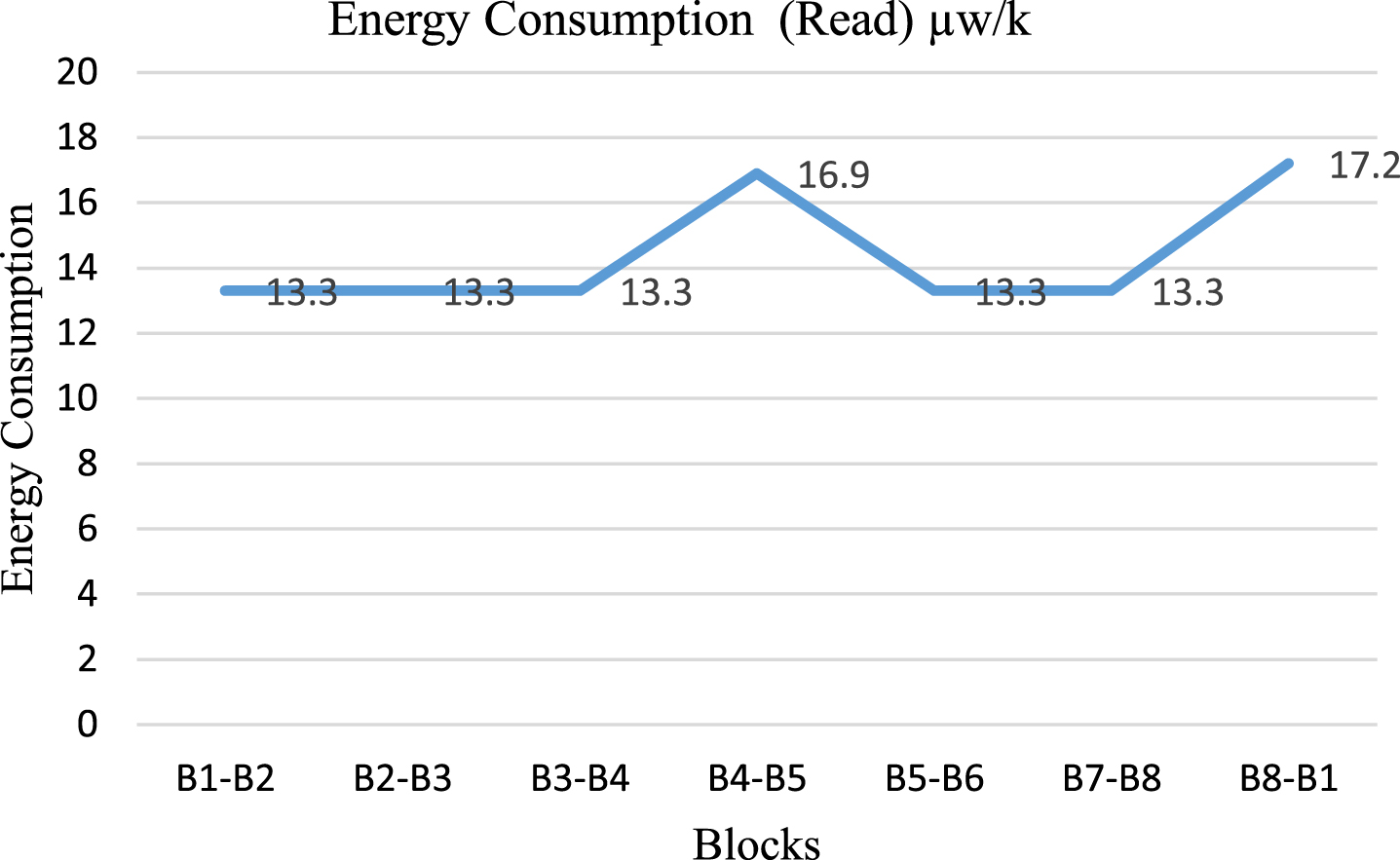
9Implementation
Figures 4, 5 and 6 shows the Implementation of blockchain to create blocks using online simulator. Using the simulator assign hashkey and crypto id to all the blocks and to transfer data to over the chain. Data movement monitored peer to peer groups [21].
Fig. 4
Block creation.
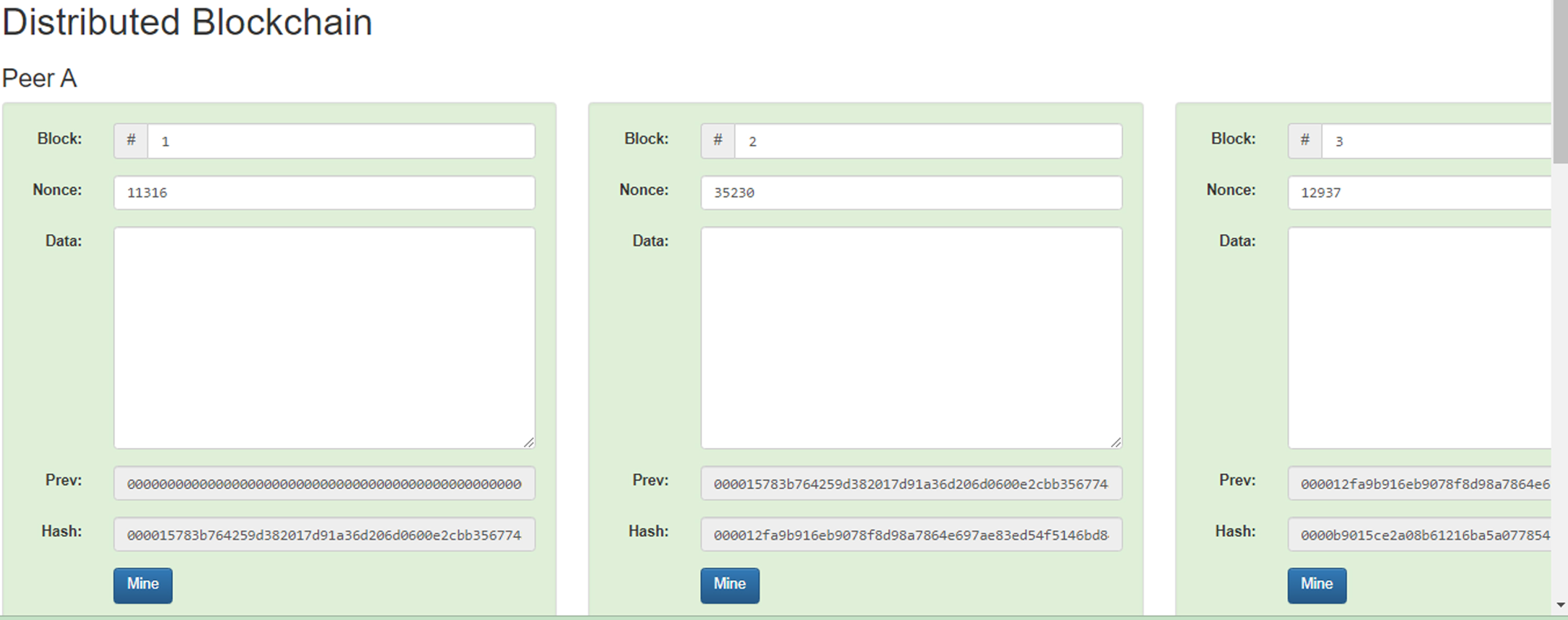
Fig. 5
Block and token id generation.
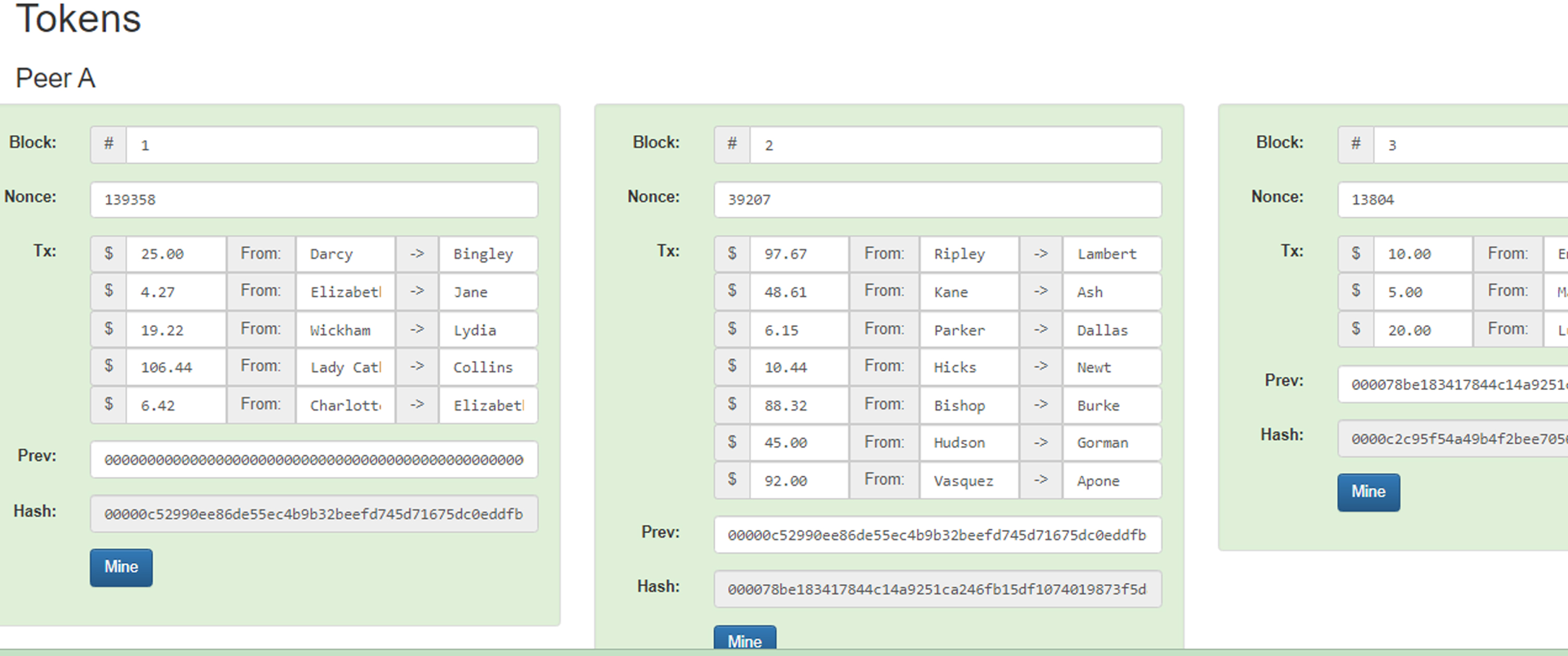
Fig. 6
Automatic peer creation.
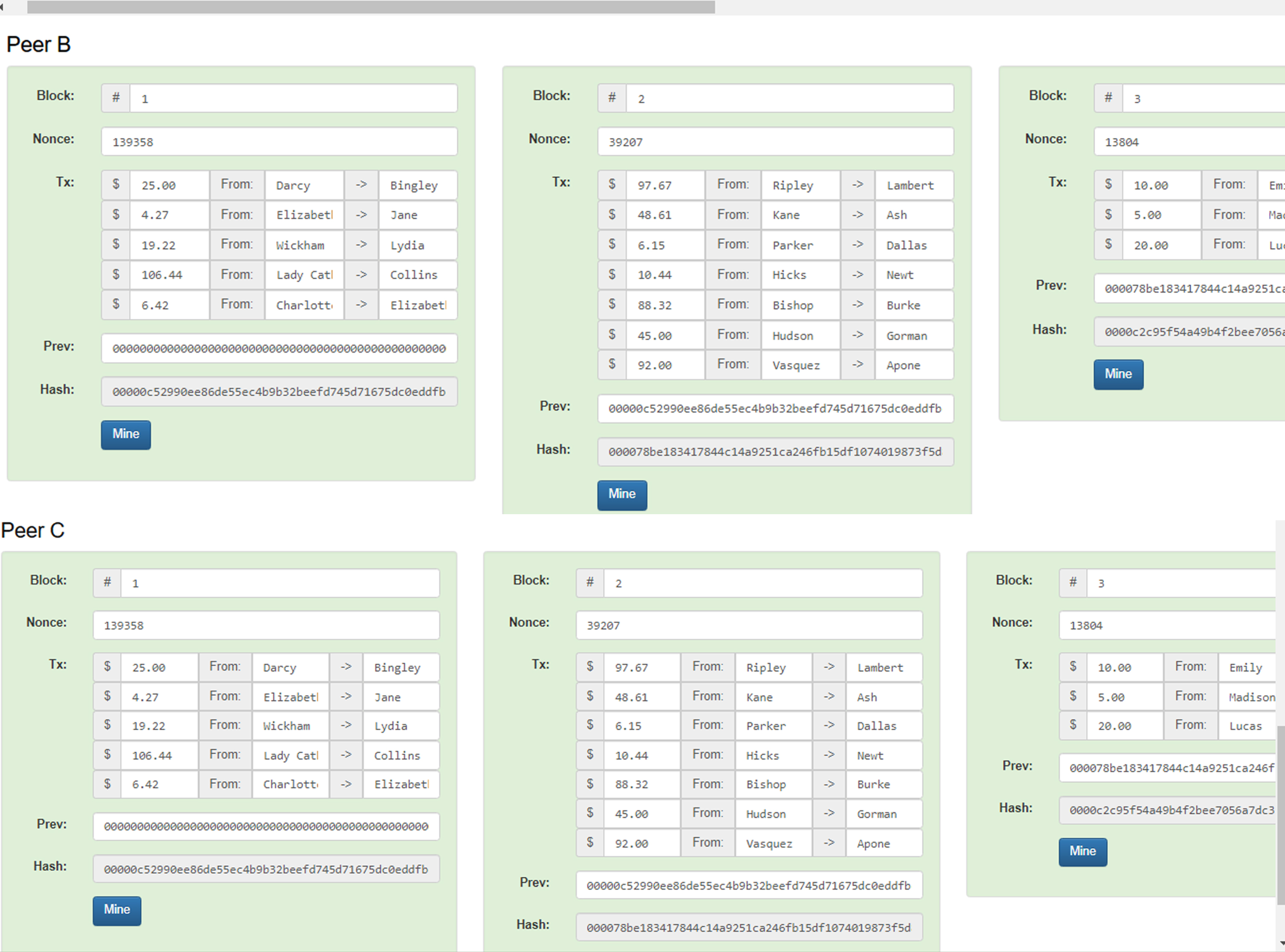
10Conclusion
Blockchain has a secured technology to secure various types of domain applications. In recent years, various methodologies are being proposed to provide enhanced trust in blockchain environment. In the proposed methodology, new concepts of CFP and Total trust energy have been introduced to provide secured service in blockchain. The given approach is illustrated with different examples in real trace in the blockchain environment. Using this concept, trust can be provided at root level of access to chain ensuring secured delivery.
References
[1] | |
[2] | Zhang S. , Ventura M.J. and Yang H. , “Network Modeling and Analysis of COVID-19 Testing Strategies,” 2021 43rd Annual International Conference of the IEEE Engineering in Medicine & Biology Society (EMBC), 2021, pp. 2003–2006, doi: 10.1109/EMBC46164.2021.9629754. |
[3] | Panwar Kuldeep; Pandey Supriya; Rawat Kamal; Bisht Neeraj, “6 Predictor System for Tracing COVID-19 Spread,” in Use of AI, Robotics, and Modern Tools to Fight COVID-19, River Publishers, (2021) , pp. 79–87. |
[4] | Shah H. , Shah M. , Tanwar S. et al. Blockchain for COVID-19: a comprehensive review, Pers Ubiquit Comput ((2021) ). https://doi.org/10.1007/s00779-021-01610-8 |
[5] | Tahir S. , Tahir H. , Sajjad A. , Rajarajan M. and Khan F. , Privacy-preserving COVID-19 contact tracing using blockchain, in Journal of Communications and Networks 23: (5) ((2021) ), 360–373. doi: 10.23919/JCN.2021.000031. |
[6] | https://www.gavstech.com/blockchain-based-platform-for-covid-19-vaccine-traceability/ |
[7] | Chowdhury, Mohammad, Ferdous, Md. Sadek, Biswas, Kamanashis, Chowdhury, Niaz and Muthukkumarasamy, Vallipuram, COVID-19 Contact Tracing: Challenges and Future Directions. (2020). 10.20944/preprints202006.0240.v2. |
[8] | Ricci, Laura, Maesa, Damiano, Favenza, Alfredo and Ferro, Enrico, Blockchains for COVID-19 Contact Tracing and Vaccine Support: A Systematic Review, IEEE Access ((2021) ), 1–1. 10.1109/ACCESS.2021.3063152. |
[9] | Enriko I.K.A. , Pramono S. , Adrianto D. and Alemuda F. , “COVID-19 Vaccine Distribution Tracking and Monitoring Using IoT,” 2021 International Conference on Green Energy, Computing and Sustainable Technology (GECOST), 2021, pp. 1–5, doi: 10.1109/GECOST52368.2021.9538791. |
[10] | Anand R. , Niyas K. , Gupta S. , Revathy S. , Anti-Counterfeit on Medicine Detection Using Blockchain Technology. In: RanganathanG., ChenJ., RochaÁ. (eds) Inventive Communication and Computational Technologies. Lecture Notes in Networks and Systems, vol 89: . Springer, Singapore. ((2020) ). https://doi.org/10.1007/978-981-15-0146-3_119 |
[11] | Wenjuan Lian, Qi Fan, Bin Jia and Yongquan Liang, A blockchain prediction model on time, value, and purchase based on markov chain and queuing theory in stock trade, Stochastic Process Theory and Its Applications 2020: ((2020) ). https://doi.org/10.1155/2020/3984924 |
[12] | Li Q.L. , Ma J.Y. , Chang Y.X. et al. Markov processes in blockchain systems, Comput Soc Netw 6: ((2019) ), 5. https://doi.org/10.1186/s40649-019-0066-1 |
[13] | Azim, Amirul, Islam, Muhammad Nazrul, Spranger, Paul, Blockchain and novel coronavirus: Towards preventing COVID-19 and future pandemics, Iberoamerican Journal of Medicine 2: ((2020) ), 215–218. 10.53986/ibjm.2020.0037. |
[14] | Fusco, Antonio, Dicuonzo, Grazia, Dell’Atti, Vittorio, Tatullo, Marco, Blockchain in healthcare: Insights on COVID-19, International Journal of Environmental Research and Public Health 17: ((2020) ), 1–12. 10.3390/ijerph17197167. |
[15] | Singh, Sandeep, Jenamani, Mamata, Dasgupta, Diptiman, Das, Suman, A conceptual model for Indian public distribution system using consortium blockchain with on-chain and off-chain trusted data, Information Technology for Development 27: ((2020) ), 1–25. 10.1080/02681102.2020.1847024 |
[16] | Giorgio Alfredo Spedicato, Tae Seung Kang, Sai Bhargav Yalamanchi, Deepak Yadav, Ignacio Cord’on “The markovchain Package: A Package for Easily Handling Discrete Markov Chains in R”, (2021) . |
[17] | Nascimento K.K.F.D. , Santos F.S.D. , Jale J.S. et al. Extracting rules via markov chains for cryptocurrencies returns forecasting, Comput Econ ((2022) ). https://doi.org/10.1007/s10614-022-10237-7 |
[18] | P. Vyshnavi, Samad, Abdus, N. Venkatesan and Avital, Eldad,, A review on the energy prospects of Indian remote Islands and preliminary assessment of marine current energy potential, Journal of Physics: Conference Series ((2020) ). 1716. 012007. 10.1088/1742-6596/1716/1/012007 |
[19] | Lewis, Adam, Ghosh, Soumik and Tzeng, Nian-Feng, Run-time Energy Consumption Estimation Based on Workload in Server Systems. HotPower, ((2008) ). |
[20] | Poonkuzhali G. , Thiagarajan K. , Sudhakar P. , Kumar R.K. and Sarukesi K. , “Spam filtering using signed and trust reputation management” ACACOS’11: Proceedings of the 10th WSEAS International Conference on Applied Computer and Applied Computational Science ((2011) ), 67–71. |
[21] |




